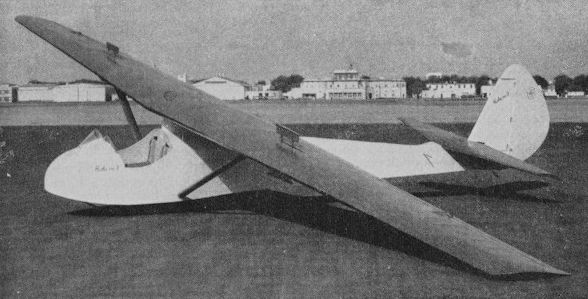
M.Hardy. Gliders & Sailplanes of the world
RG-1 Rohini-1
Resembling the Slingsby T21B Sedbergh, the RG-1 Rohini-1 side-by-side two-seater trainer was the first type designed at the Technical Centre of India's Civil Aviation Department to go into production in more than small quantities. Starting with an open-cockpit primary type glider first flown in November 1950, the Technical Centre built two Model PT-G open-cockpit primary single-seaters based on the ESG design, six Model IT-G intermediate trainers based on the Grunau Baby, two Model AS-1 high performance sailplanes based on the Olympia and five Ashvini tandem two-seater trainers resembling the DFS Kranich; 11 more Ashvinis were built by Aeronautical Services Ltd of Calcutta. Next of the Centre's types to appear was the RG-1 Rohini-1, designed by S. Ramamritham, who eventually became the Centre's Director-General, and it first flew on 10 May 1961; four prototypes were built at the centre between 1961 and January 1964. Since the Centre does not undertake quantity production of its gliders, but supplies complete sets of drawings of its designs to any firms interested in manufacturing them, the Rohini went into production elsewhere, 17 examples being built by Veegal Engines and Engineering Co of Calcutta and a further 86 by Hindustan Aeronatuics Ltd at its Kanpur Division. To minimise production costs the tail surfaces, air brakes and many wing ribs of the Rohini were made identical to those of the earlier Ashvini. Of all-wood construction, the Rohini has a braced high wing which is a two-spar structure, plywood-covered to the rear spar and with a fabric-covered trailing edge; the fabric-covered wooden ailerons have ply-covered leading edges, and there are air brakes above and below the wing on each side. The fuselage is built as a one-piece structure with integral fin, the forward portion to the wing rear spar attachment and the rear portion aft of the tailplane front attachment bulkhead being plywood-covered wooden semi-monocoques, whereas the remaining centre and rear portions have a fabric-covered wooden girder structure. The cantilever wooden tail has a plywood-covered fin and fabric-covered rudder, tailplane and elevators except for the leading edges and that part of the tailplane between the two root ribs, which are ply-covered. There is a trim tab in the starboard elevator. The landing gear consists of a non-retractable unsprung Dunlop monowheel and tyre, with no brake, and a rubber-sprung nose skid under the forward fuselage with a replaceable steel shoe; there is a spring steel tail skid. The two pilots sit side-by-side in an open cockpit with small windshields.
Span: 54 ft 4 in
Length: 26 ft 9 1/2 in
Height: 7 ft 7 3/4 in
Wing area: 223.3 sq ft
Aspect ratio: 13.2
Empty weight: 604 lb
Max weight: 1,089 lb
Max speed: 108 mph (in smooth air)
Max aero-tow speed: 70 mph
Min sinking speed: 2.35 ft/sec at 38 mph
Best glide ratio: 22:1 at 48 mph
- M.Hardy. Gliders & Sailplanes of the world
Фотографии
-
Jane's All the World Aircraft 1972 / 03 - Sailplanes
Rohini-I side-by-side two-seat training sailplane
- Фотографии
